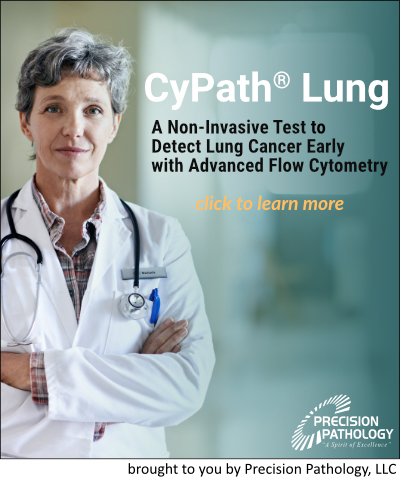JULY 20, 2018
As published in GenomeWeb’s 360Dx
By Leo O’Connor
NEW YORK – BioAffinity Technologies has begun clinical validation of a test for the early detection of lung cancer that uses flow cytometry and detects porphyrin molecules in sputum samples.
The San Antonio-based firm anticipates that its CyPath Lung diagnostic assay will be available as a laboratory-developed test from a CLIA-certified laboratory early next year, and is in discussion with an undisclosed lab that wants to license the technology, its CEO Maria Zannes said in an interview.
BioAffinity has begun validation testing at four sites and anticipates adding at least another four to clinically test 200, or more, sputum samples prior to completing the trial before the end of this year.
Zannes said clinicians will be able to use the test to determine whether patients have received false-positive results using low-dose computer tomography (LDCT), a technique that they frequently use to diagnose lung cancer. By flagging false-positive results, the clinicians will be able to avoid doing biopsies or other invasive procedures.
Running on a flow cytometer, BioAffinity’s CyPath Lung assay uses a specific type of porphyrin molecule — TCPP — that displays an unusually high affinity to cancer cells. When a cancer cell binds to a porphyrin molecule, it fluoresces, giving the test a way to distinguish between those that are healthy and those that carry cancer.
“BioAffinity’s test using fluorescence technology is a unique and promising approach which will hopefully lead to earlier lung cancer diagnosis with better outcomes, while avoiding the morbidity and mortality of invasively evaluating non-cancerous lesions,” said David Hill, chairman of the board of directors of the American Lung Association of the North East, who is not involved in developing the test.
CyPath Lung uses multiple parameters in deciding whether cells are cancerous, and this strengthens the test, Zannes said. Parameters include not only counting the number of cells that take up high levels of porphyrin, but also counting red and white blood cells and non-blood cells.
The current validation trial follows earlier clinical studies that led to the final design of the non-invasive test, the firm said. Specifically, CyPath Lung analyzes sputum to find cancer cells that have separated from a lung tumor. Because the test runs on a flow cytometer, a mainstay instrument in many laboratories, it can be made broadly available, Zannes said. BioAffinity anticipates that clinicians will receive test results in about two days after a sample reaches the laboratory.
The testing process involves high-risk lung cancer patients collecting sputum samples from home. After ordering a test based on a physician’s prescription, a patient collects sputum samples over three days using a handheld Acapella collection device produced by Smith Medical that applies positive expiratory pressure to mobilize pulmonary secretions. The test subject refrigerates the sample and on the third day removes the sample cup from a refrigerator and sends it off with an ice pack in an envelope addressed to a clinical lab.
In an internal trial with 300 samples, 98 percent were found to be suitable for analysis by flow cytometry, Zannes said.
During processing, labs convert the sputum sample to a single-cell suspension suitable for use by a flow cytometer. The single cell suspension is labeled with the porphyrin compound and antibodies that distinguish different cell types in the flow cytometer. The test removes unnecessary cells and debris to make the sample suitable for use by flow cytometry and enables identifying 12 different types of cells. Based on the uptake of porphyrin in the sample, the test is able to determine whether the patient has cancer.
Flow cytometry enables the analysis of up to 40 million cells in a sample in less than one hour, Zannes said. Because of its ability to analyze different types of cells, the platform may eventually be able to identify and distinguish patients with chronic obstructive pulmonary disease and asthma from those with other respiratory conditions. The firm is working to develop these assays, but they are years away from commercialization, and the primary focus now is on commercializing its test for lung cancer, Zannes said.
Four clinical sites — Summit Medical Group in New Jersey, Radiology Association of Albuquerque in New Mexico, Waterbury Pulmonary Associates in Connecticut, and Atlantic Health Systems in New Jersey — are enrolling volunteers for the CyPath lung diagnostic validation trial. Four additional collection sites are undergoing review and approval by Institutional Review Boards. “This will be an eight to 10 site clinical test validation trial,” Zannes said, adding that future sites will be “larger, major medical” facilities as it moves towards its objective of testing 200 patient samples, or more.
The trial has three distinct cohorts. First, a healthy cohort consists of people who are not currently smoking and who smoked less than one pack of cigarettes each day for five years. To be included in this cohort, people who smoked needed to quit more than 15 years ago and have no known lung disease. Second, a high-risk cohort consists of people between the ages of 55 and 74 who are current smokers, smoked at least one pack of cigarettes each day for the past 30 years, and quit smoking within the past 15 years. Participants in this cohort will undergo LDCT scans to confirm they do not have lung cancer. Third, a lung cancer cohort consists of people who a physician suspects have lung cancer but have not had a biopsy or received therapy. After providing a sputum sample, people in this cohort are confirmed to have lung cancer by biopsy.
Clinicians will process each subject’s sputum specimen at BioAffinity’s laboratory at the University of Texas in San Antonio or at the ResearchDx laboratory in Irvine, California.
“The most important test of an early lung cancer diagnostic is its ability to diagnose and differentiate those people who have cancer from high-risk individuals,” Zannes said. “Those two cohorts can be very similar in their pathology.”
Patients will receive reimbursement for the test using the CPT code for flow cytometry, at a rate of $380 per test, she added.
Current screening
Lung cancer is the leading cancer killer worldwide and claims nearly 1.6 million lives annually. Its five-year survival rate is only 18 percent, largely because it is detected so late, and about 60 percent of patients die within one year after diagnosis.
Studies show that the survival rate can increase to more than 90 percent if lung cancer is caught early and treatment can begin, according to BioAffinity. If detected and treated at Stage 1, the survival rate improves to 88 percent for 10 years.
According to the American Lung Association, screening high-risk individuals with LDCT scans could reduce lung cancer mortality by 20 percent compared to chest X-ray. In the US, at least 8.6 million people qualify as high risk for lung cancer and are recommended to receive annual LDCT screening, it said.
Hill, also an assistant clinical professor of medicine at Yale University School of Medicine and director of clinical research at Waterbury Pulmonary Associates, noted that BioAffinity is one of several companies attempting to develop laboratory testing to aid in screening at risk patients for lung cancer.
The goal of screening is to identify lung cancers early when treatment can be curative, but most lung cancers are currently identified at a late stage when they become symptomatic and the prognosis of this disease is extremely poor, he said.
“Currently, low-dose CT scans are indicated for lung cancer screening in a select group of patients with heavy smoking histories,” Hill noted. “Unfortunately, these CT scan have a relatively high false-positive rate with small nodules of uncertain etiology and behavior being identified.”
According to Zannes, LDCT has a false-positive rate as high as 96 percent and can lead to unnecessary invasive procedures.
CyPath Lung is intended for use as a companion to low-dose CT for those individuals who test positive or have a suspicious nodule, and a pulmonologist is not sure whether the patient should have a biopsy or bronchoscopy or other invasive procedure, Zannes said.
Seeking funds
BioAffinity is seeking up to $15 million in funding as part of a Series B round that would take it through commercializing the CyPath lung cancer diagnostic test. Last year, it raised more than $4 million from private investors in Series A financing.
The firm has 50 patents in 21 countries covering its lung cancer diagnostic technology, Zannes noted, adding BioAffinity has 13 employees, 10 of whom are scientists.
In going to market, the firm is considering a multipronged approach. One is to license its tests to laboratories, including CLIA-certified and reference labs. Another approach is to potentially become a strategic partner with a large IVD company or laboratory that would provide sales and distribution capabilities for its tests. The firm could also decide to build its own sales and marketing team, Zannes said.
The firm expects to receive CE marking for its lung cancer diagnostic test in 2019 in collaboration with an undisclosed IVD industry partner.
Zannes noted that the test platform is suitable for identifying other types of cancer, and the company anticipates starting next year to develop a prostate cancer assay for testing and screening urine samples.
The firm said that it is also developing treatments to selectively deliver cytotoxins to cancer cells using other porphyrin molecules.

